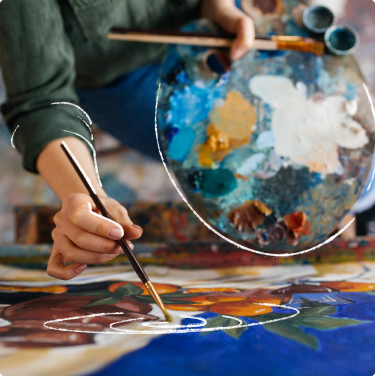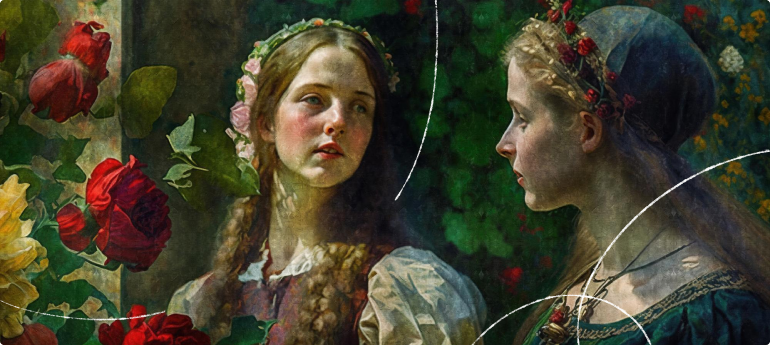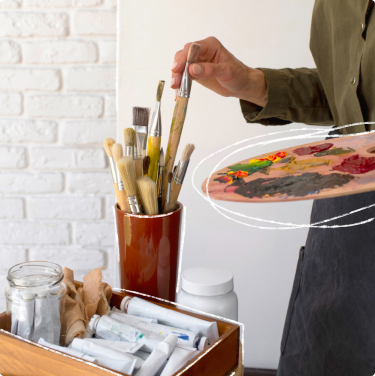In the world of visual art, the eternal question remains: what is easier — creating masterpieces with oil paints or acrylics? This dilemma is the subject of passionate debates among artists.
Each of these techniques has its own unique characteristics, sparking excitement and inspiration in creative minds. Let’s dive into the fascinating world of painting and explore the essence of the debate.
Acrylic art: why acrylic paintings are attractive
Art has always been a means of self-expression and exploring the world around us. However, with the advancement of technology and the introduction of new materials, artists have gained the opportunity to broaden their horizons in the realm of art supplies. In recent years, acrylic art has become particularly popular.
Why?
-
Bright World of Colors: Acrylic paints offer a rich palette of vibrant and saturated colors. Acrylics are appealing to those who seek to emphasize the expressiveness of their work. The colors of acrylics maintain their brightness and intensity even after drying, which is very impressive.
-
Fast Drying: One of the advantages of acrylic paints is their quick drying time. Unlike oil paints, acrylics dry within a matter of hours.
-
Variety of Techniques and Textures: Acrylics allow artists to experiment with textures and techniques, from creating textured strokes to using glazing or dripping techniques. This variety of approaches enables each artist to find their unique style.
-
Versatility in Art: Acrylics can be used on various surfaces: canvas, wood, paper, fabric, and even plastic.
-
Modernity: Acrylic art is often used in contemporary art movements such as abstraction, surrealism, and hyperrealism. Its bright colors and ability to create complex textures make acrylics a wonderful tool for bringing innovative artistic ideas to life.


Acrylic art attracts artists with its versatility and liveliness, and viewers with its ability to feel the emotions and ideas of the artists.
Acrylic always means bright colors and creative experiments.
Oil painting: why oil paintings are attractive
Among the various painting techniques and styles, oil painting holds a special place, captivating with its unique beauty. What makes oil paintings so appealing, and why do they continue to mesmerize viewers for centuries?
-
Depth of Color: A key feature of oil painting is its ability to convey depth and richness of color. By using oil paints, an artist can create a canvas palette enriched with a wide range of hues.
-
Oil painting is also known for its durability: Oil paintings can maintain their quality and brightness for many generations. We, the viewers, enjoy artworks created decades or even centuries ago.
-
Technical Mastery: Working with oils requires the artist to not only master the techniques of mixing and applying paint but also to have a sense of composition, light, and shadow. This labor-intensive art demands patience and dedication from the creator.
-
Enchanting Beauty: Ultimately, the allure of an oil painting lies in its mesmerizing beauty. This art form can transport us to another world filled with colors, emotions, and stunning harmony.

Good to know: oil painting boasts a rich history dating back several centuries. It first became popular in Europe in the 15th century, and it was during this time that artists began to widely use oil paints.
The main differences between acrylic and oil paints
Between these artistic materials, there are two main differences:
![]()
- Acrylic paints are created with an acrylic polymer base, which is water-soluble. This makes them versatile and suitable for various conditions. Acrylics mix easily with water, allowing for the creation of different textures and effects.
- Oil paints are based on oil, usually linseed or walnut oil. They are denser and dry slowly, giving the artist more time for creativity, especially if corrections or additional details are needed in the painting.
![]()
- Acrylic paints dry quickly, sometimes within a few hours. Therefore, the artist needs to work dynamically and steadily, applying layers and details without long breaks.
- Oil paints, on the other hand, dry slowly, allowing the artist more time to work, extending the creative process. There is time to experiment with shapes and colors.


Alsooil paintsare known for their durability and ability to maintain color brightness for many years. Acrylic paints also have good durability, but are less resistant to ultraviolet radiation.
Features of acrylic and oil paints
Acrylic | Oil |
|---|---|
The paint is water based, so it dries very quickly. Can dry in an hour. | These paints are durable, and almost all of the world’s outstanding classical paintings are created using oils. |
Rarely cracks. |
Preserves color and saturation. |
After drying it acquires a darker shade. | Not exposed to temperature changes. |
Easy to mix with other components and materials. | Thanks to the slow drying process of the paint, the artist has the opportunity to correct imperfections in his work |
Does not require varnishing. | Fits well on canvas, paper, wood, metal. |
Without smell. | Has a specific smell. |
Easy to wash off with water, does not shine and does not create glare in the sun. | To wash off oil paint, a special thinner is required. It is difficult to wash off from many surfaces, such as the floor. |
In art, as in life, there are no strict boundaries or rules. Choosing between acrylic and oil paints is not just a choice of material but a choice of one’s artistic path.
Each of these paints is a unique language through which the artist tells their own distinctive story.
Another interesting feature is that acrylic paints are less expensive than oil paints.

Advantages and disadvantages of oil painting
From the masters of the Renaissance to contemporary artists, oil painting has captivated with its virtues, but it has also come with some challenges.
Advantages of oil painting:
- Color richness: oil paints are renowned for their richness and depth of color. Artists work with intense hues that retain their brightness even after the paint dries.
- Slow drying: slow drying gives artists more time to work on details.
- Smoothness and oil gloss: oil paints create a smooth surface with a pleasant gloss, adding sophistication and elegance to the artwork.
- Mixing capability: artists often use oil paints to achieve unique shades through mixing, resulting in more complex and rich artworks.
Disadvantages of oil painting:
- Long drying time: however, the slow drying of oil paints can also be a disadvantage. This is particularly inconvenient when the artist wants to finish the project quickly.
- Odor and toxicity: oil paints can have a distinctive smell, and some contain toxic substances. This is a concern for artists working in small or poorly ventilated spaces.
- Need for special canvas: oil paints require special canvas or primer, which adds to the cost of materials.
Of course, you will face some challenges if you want to work with oil. But it is these very challenges that make the art even more exciting.


Advantages and disadvantages of painting with acrylic paints
Advantages:
- Fast drying: acrylic paints have the remarkable ability to dry quickly, giving the artist the freedom to experiment with forms and colors. This feature makes acrylics an ideal choice for those who aim to create a work of art in a short period.
- Versatility in use: these paints are true all-rounders, capable of transforming any surface into a canvas for your creativity. Whether it’s canvas, wood, paper, or fabric—acrylics easily adapt to everything and give your creation a unique character.
- Ease of application: with almost no odor and minimal toxicity, acrylic paints make the creative process pleasant and comfortable. They are also easily washed off with water, simplifying the cleaning of brushes and equipment.
Disadvantages of acrylic painting:
- Fast drying: the quick drying of acrylics can be a real challenge for those who prefer a slower pace of work.
- Color change: sometimes the color of acrylic paints can slightly change after drying—such as darkening.
- Oxidation and loss of gloss: over time, acrylics are subject to oxidation, and the painting may unfortunately lose its initial gloss.
If you look closely, acrylic paints have become a reliable companion in our everyday life and artistic activities, and it would be unwise to neglect them.
This type of paint has many advantages, and perhaps the most obvious are ease of use and quick drying.
Acrylic underpainting for oil painting
Acrylic paints are a unique medium that blends easily with various artistic techniques. Their versatility also extends to their ability to interact beautifully with oil paints. When used as an underpainting, acrylic provides a solid foundation that serves as an excellent base for subsequent layers of oil paint.
So why does acrylic become the ideal ally for creating underpaintings for oil works?
- Acrylic is versatile: it easily combines with oil paints. This art alliance allows the artist to create harmonious and layered works where each type of paint complements the other, enriching the color palette and textural elements.
- Ease of correction: in the creative process, changes are important, and acrylic provides maximum flexibility in this regard. The ability to easily correct details or create new elements offers freedom of expression and experimentation in the underpainting process.
- Durability and resilience: acrylic paints are known for their durability and resilience. These qualities are especially important when creating an underpainting, as it serves as the foundation for subsequent layers of oil paint. A strong and durable underpainting ensures the longevity and quality of the artwork for many years.
- Economy: acrylic is cheaper than oil paint. And cost savings do not mean poor quality; on the contrary, acrylic provides high quality at a more affordable price.
Fast drying, ease of correction, durability, and economy—acrylic serves as an ideal tool for those seeking functionality in the world of oil painting.
Question-answer
Oil paint requires patience due to its long drying time but allows for the creation of rich textures and deep colors. Acrylic dries quickly, enabling faster experimentation and work, but its opacity is not to everyone’s liking.
Ultimately, the choice depends on your style, preferences, and what you wish to express in your art.
Acrylic paints are great for beginners as they dry quickly and mix easily with each other. You can experiment with different colors and tones, creating a variety of textures and effects on the canvas. The advantages of acrylic paints include their low toxicity and safe use in enclosed spaces.
On the other hand, oil paints are renowned for their richness and vibrancy. While they dry more slowly, they allow artists more time to work on details and create smooth transitions. Oil paints boast a rich history and have been used in classical art for many centuries.
So, beginning artists are advised to start with acrylic paints as they are cheaper and relatively easy to use. They are also easily removed from the canvas surface.
Oil paints and acrylic paints are two different worlds of painting. Oil paints have deep hues, dry slowly, and allow the artist to express details meticulously. Acrylics, on the other hand, dry quickly, feature vibrant colors, and offer flexibility in technique, providing greater freedom.
Choosing the type of paint depends on the style, speed of work, and preferences of the artist.
Oil paints are characterized by their thick consistency and long drying time. They have high pigmentation, allowing for rich and glossy colors.
Oil paints also mix easily on the palette, giving a wide range of shades. They are ideal for detailed work and for creating effects of texture and depth. However, oil paints require special solvents and chemical hardeners, and they dry slowly (several days or even weeks), making them less suitable for artists who want to work quickly.
Acrylic paints, on the other hand, dry quickly and have a more transparent consistency. They are excellent for layered techniques or creating transparent effects. Acrylic paints dilute easily with water and can be applied to canvas as well as other surfaces like wood or plastic.
Ultimately, the choice between oil and acrylic paints depends on the artist’s preferences and the requirements of the specific project. Some artists prefer oil paints for their rich and deep tones, while others favor acrylics for their ease of use.
Acrylic paints usually dry much faster than oil paints. Acrylics can dry within a few hours, depending on the thickness of the layer and the environment. Oil paints, on the other hand, can take weeks to dry.
Yes, in some cases, it is possible to replace oil paint with acrylic paint, but there are a few important aspects to consider:
- Surface for painting: if you are working on a canvas or another surface specifically designed for oil paints, acrylic paint may not adhere as well as oil paint.
- Application technique: acrylic paints dry quickly and usually lose their form, so the application technique may differ from what you use with oil paints.
- Color durability: depending on the manufacturer and quality of the paints, the colors of acrylic and oil paints may differ slightly. Also, oil paints may change their color over time, whereas acrylic paints are usually more resistant to ultraviolet radiation.
Yes, you can mix oil paint with acrylic paint, but there are a few important points to consider:
- Base: oil paints have an oil base, while acrylic paints have a water base. Therefore, it is better to use oil paints as a base and then add acrylic paints.
- Layers: usually, applying oil paints over acrylic paints will not cause problems. However, if you plan to apply acrylic paints over oil paints, it’s better to add a layer of isolating medium to prevent reactions between the two types of paint.
- Drying: oil paints generally dry slower than acrylic paints. Their mixing might affect the drying time of your painting. Keep this in mind when planning your working time.
- Durability: start with acrylic paints if you need bright and vibrant colors, and then add details with oil paints.
- Technique: some artists prefer to mix paints on the palette rather than on the canvas to better control colors and textures.




